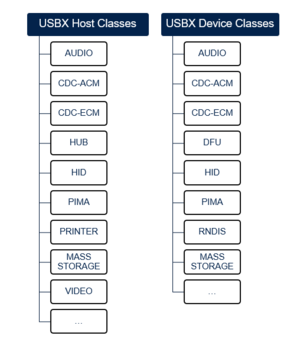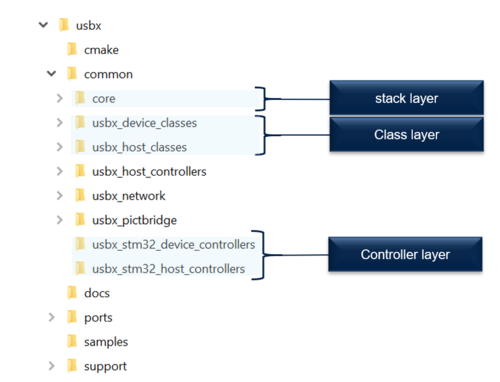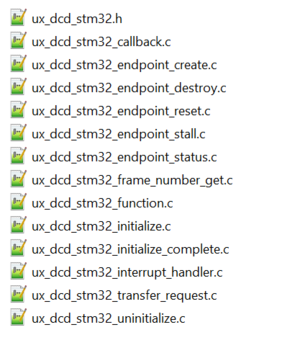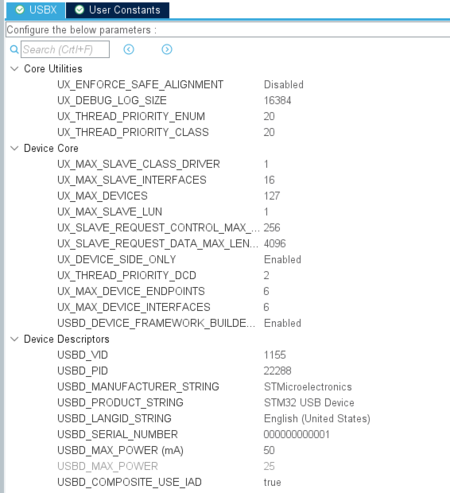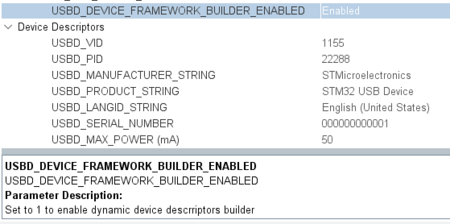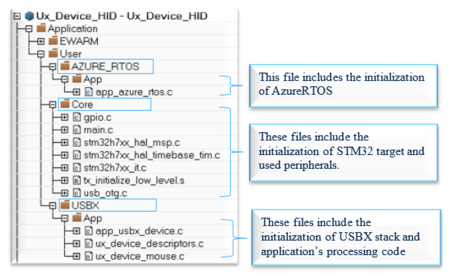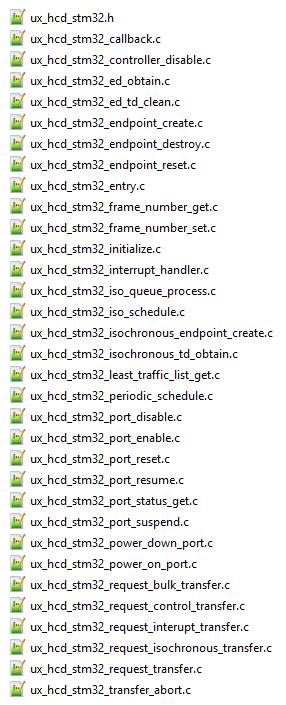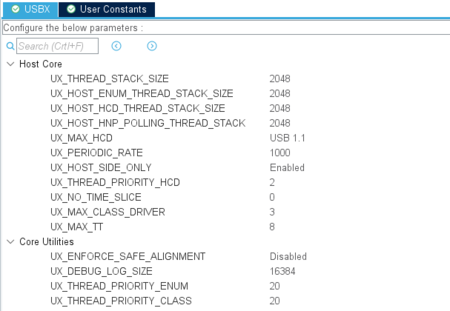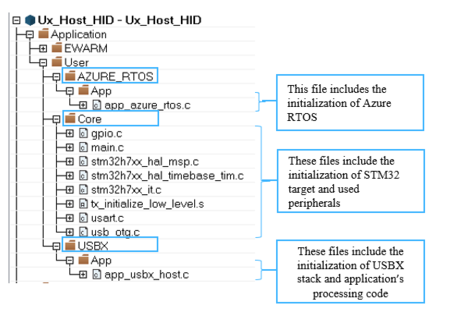1. Introduction
Besides offering STMicroelectronics’s USB stack, USBX, the Azure RTOS USB embedded stack, is currently supported and offered with a set of applications on STM32 MCUs.
The USB overview is a dedicated wiki page that was implemented to provide a general overview of the Universal Serial Bus and its main features.
USBX is the Azure RTOS USB Host and USB Device embedded stack. It is tightly coupled with ThreadX. For some classes, it requires the FileX and NetX Duo stacks. It allows to work with USB devices with multiple configurations, composite devices, USB OTG and supports the USB power management.
USBX provides both USB Host and USB Device stack with a large set of the USB classes. The modular architecture makes the porting on different USB hardware IPs easier as soon as the low-level driver can answer the USBX requests. In the STM32 context, the USB IPs either host or device, vary from a family to another. Even though all IP should be supported transparently by the USBX thanks to the common STM32 HAL driver API.
Note: The bare metal implementation will be available in the future (ie. using USBX without need for ThreadX).
USBX provides all common USB features and classes. The following figure provides the list of currently supported classes:
- HUB class will be available in the future on specific products.
Besides ThreadX integration with USBX, the USB events are managed through interrupts.
The USBX stack has mainly three layers:
- The lower layer is the controller layer that ensures the interfacing with the Hardware USB peripheral and for STM32 MCUs this layer is compatible with the HAL.
- The middle layer ensures the USB stack requirements processing and the interfacing between the low and high layers.
- The higher layer includes the different classes and ensures the interfacing with the application layer.
The following figure provides an overview of the USBX three layers architecture and main components.
As presented in the following figure, the different layers can be easily found within the USBX folder.
For more details, please refer to Azure RTOS USBX documentation.
2. USBX Device for STM32
This section provides the main guidelines allowing to use the USBX Stack with the HAL on the STM32 MCUs.
2.1. STM32 Device Porting layer
As described in the previous section, the USBX is based on three layers that must be referenced within any application project. To be able to interface with the STM32 HAL, the project must integrate the STM32 Device controllers. The drivers presented in the figure below include all the APIs allowing the interfacing with the STM32 HAL.
2.2. How to customize
After referencing the required drivers and depending on the class’ and application’s requirements, the following points must be verified:
1. Add the convenient Descriptors: the device descriptor, configuration descriptor, interface descriptor, endpoint descriptor and the Strings (Language ID, Product ID, and Vendor ID, manifacturer, etc.). The following figure shows some of the required definitions for the HID class:
Note: for reference, all the required descriptors can be found in the ux_device_descriptors.c/.h files within the provided STM32 HID device application.
2. Add the Class parameters: every class needs to interface with the user application through some variables or functions. Thus, for every class, there is a structure that must be filled before registering the class. Example for the HID application, the following structure must be filled to be able to register the class:
3. Customize the USBX built options by modifying the status of the different conditional compilation defines in ux_user.h file such as:
• USBX thread stack size.
• The maximum class number that can be loaded by USBX.
• The maximum number of devices that can be attached into one USB system.
• Maximum endpoints number.
• The device used class(es).
• The device state side use.
4. Depending on the application’s requirements, all required peripherals, and resources (UART, I2C, etc) must be initialized generally in the stm32XXxx_hal_msp.c file (XX is the family name that can be h7, f7, etc).
Note: to make sure that all the customized defines in the ux_user.h file are taken into consideration, the "UX_INCLUDE_USER_DEFINE_FILE" should be added within the preprocessor defined symbols.
When configuring the project using STM32CubeMX and the X-CUBE-AZRTOS-XX package, a list of variables can be customized through the interface before generating a device application the project.
To know the role of every variable just click on it and a little window will show the description. For instance, "USBD_DEVICE_FRAMEWORK_BUILDER" allows to enable or disable the device framework builder.
2.3. How to use the USBX Device stack to implement an application?
1. To start the USBX application, ThreadX must be initialized as described in How to use ThreadX section.
2. Initialize the USBX controller data structures and allocate the required memory.
/* Initialize USBX Memory & data structures */
ux_system_initialize(pointer, USBX_MEMORY_SIZE, UX_NULL, 0);
3. Prepare the Device, string and LangID frameworks.
/* Get_Device_Framework_High_Speed and get the length */
device_framework_high_speed = USBD_Get_Device_Framework_Speed(USBD_HIGH_SPEED,
&device_framework_hs_length);
/* Get_Device_Framework_Full_Speed and get the length */
device_framework_full_speed = USBD_Get_Device_Framework_Speed(USBD_FULL_SPEED,
&device_framework_fs_length);
/* Get_String_Framework and get the length */
string_framework = USBD_Get_String_Framework(&string_framework_length);
/* Get_Language_Id_Framework and get the length */
language_id_framework = USBD_Get_Language_Id_Framework(&languge_id_framework_length);
Note: the descriptors must be implemented at application level to be provided as parameters when initializing the stack. For reference, all the required descriptors can be found in the ux_device_descriptors.c/.h files within every provided STM32 device application.
4. Initialize the USBX device stack with the prepared frameworks.
/* The code below is required for installing the device portion of USBX.
In this application */
ret = ux_device_stack_initialize(device_framework_high_speed,
device_framework_hs_length,
device_framework_full_speed,
device_framework_fs_length,
string_framework,
string_framework_length,
language_id_framework,
languge_id_framework_length, UX_NULL);
5. Initialize the device class parameters and register the class.
/* Initialize the device class. The class is connected with interface 0 in this case */
ret = ux_device_stack_class_register(_ux_system_slave_class_xxxx_name,
ux_device_class_xxxx_entry, 1, 0, (VOID *)&class_xxxx_parameter);
6. Initialize the USB hardware peripheral and start the controller.
7. Implement the required applications tasks using Threads or Message Queue as explained in ThreadX section paragraph 4.
Note: The bare metal implementation will be available in the future (ie. it will be possible to use USBX without need for ThreadX).
2.4. USBX Device Applications
This section provides an overview about the offered USBX Device applications on STM32 MCUs.
2.4.1. USBX Device applications architecture
The Following figure shows the project architecture and main application’s files.
2.4.2. USBX Device applications overview
The following table provides an overview about the offered USBX Device applications:
| USBX Device application | Overview |
|---|---|
| HID Application | This application aims to make the STM32 emulate a Mouse USB Device. When connected to a host through its USB peripheral, The STM32 will be detected as an STM32 HID Mouse. The cursor moves automatically. For more details, please refer to the application’s Readme file. This application was implemented according to the Device Class Definition for Human Interface Devices (HID) specification. |
| MSC Application | This application aims to make the STM32 emulate a Flash Disc Device. When connected to a host through its USB peripheral, The STM32 will be detected as an STM32 Mass Storage Device. The device can then be written, read and formatted. For more details, please refer to the application’s Readme file. This application was implemented according to the Universal Serial Bus Mass Storage Class specification. |
| CDC Application | This application aims to make the STM32 emulate an UART-USB Bridge. When connected to a host through its USB peripheral, The STM32 will be detected as an STM32 Virtual Com port. An HyperTerminal can be opened with the detected port and a communication can be established between the STM32 Virtual comport and the STM32 ST-link (UART) port. For more details, please refer to the application’s Readme file. This application was implemented according to the Class definitions for Communication Devices specification. |
| Ux_Device_HID_CDC_ACM | This application provides an example of Azure RTOS USBX stack usage on STM32H747I_Discovery board, it shows how to develop a composite USB Device communication Class "HID" and "CDC_ACM" based application. The application is designed to emulate an USB HID mouse device and USB-to-UART bridge following the Virtual COM Port (VCP) implementations. For more details, please refer to the application’s Readme file. |
| ECM Application | This application shows how to implement an application able to run Web HTTP server stack over USB interface using the CDC-ECM class. When an SD card is inserted into the STM32 Board's SD-card reader and the board is powered up and connected to DHCP enabled Ethernet network, the green LED switches ON in case the Web HTTP server was successfully started. For more details, please refer to the application’s Readme file. |
3. USBX Host for STM32
This section provides the main guidelines allowing to use the USBX Host Stack with the HAL on the STM32 MCUs.
3.1. STM32 Host Porting layer
As described in the previous section, the USBX stack is based on three layers that must referenced within any application project. To be able to interface with the STM32 HAL, the project must integrate the STM32 Host controllers interfacing with HAL layer. The drivers presented in the figure below include all the APIs allowing the interfacing with the STM32 HAL.
3.2. How to customize
1. Customize the USBX built options by modifying the status of the different conditional compilation defines in ux_user.h file such as:
• USBX thread stack size.
• The maximum class number that can be loaded by USBX.
• The maximum number of devices that can be attached into one USB system.
• The maximum endpoints number.
• The host used class(es).
• The host state side use.
2. Depending on the application requirements, the different peripherals and clocks should be correctly defined. Generally, the different peripherals IOs initialization is done in the stm32XXxx_hal_msp.c (XX is the STM32 family that can be h7, f4, f7, etc).
Note: to make sure that all the customized defines in the ux_user.h file are taken into consideration, the "UX_INCLUDE_USER_DEFINE_FILE" should be added within the preprocessor defined symbols.
When configuring the project using STM32CubeMX and the X-CUBE-AZRTOS-XX package, a list of variables can be customized through the interface before generating a device application the project.
To know the role of every variable just click on it and a little window will shows the description.
3.3. How to use the USBX Host stack to implement an application?
1. To start the USBX application, ThreadX must be initialized as described in How to use ThreadX section.
2. Initialize USBX’ different data structures that will be used by the USB System.
/* Initialize USBX memory. */
if (ux_system_initialize(pointer, USBX_MEMORY_SIZE, UX_NULL, 0) != UX_SUCCESS)
{
ret = UX_ERROR;
}
3. Register an error callback function to be able to get the error events at application level (this step is optional). This callback will be called when an error occurs at thread level or at interrupt level. It can be called to inform user with the error codes that can be related to the host controller, the device controller, the initialization, the class, the device stack, etc.
/* register a callback error function */
_ux_utility_error_callback_register(&ux_host_error_callback);
4. Initialize the USB Host stack
/* The code below is required for installing the host portion of USBX. */
if (ux_host_stack_initialize(ux_host_event_callback) != UX_SUCCESS)
{
status = UX_ERROR;
}
Device status check: in fact, ux_host_stack_initialize() is the function allowing the initialization of the USB host stack, it takes as parameter a change event callback allowing the user application to know the device status if defined. In fact, this callback, if required, should be defined at application level. It will be called when the device status is modified (inserted, removed, etc) allowing the user to perform the required process following that event.
5. Register the class
/* Register the convenient class. */
if ((status = ux_host_stack_class_register(_ux_system_host_class_xxxx_name,
_ux_host_class_xxxx_entry)) != UX_SUCCESS)
{
status = UX_ERROR;
}
6. Initialize the USB hardware peripheral.
7. Register all the available USB Host controllers with the USBX stack.
/* Register all the USB host controllers available in this system. */
if (ux_host_stack_hcd_register(_ux_system_host_hcd_stm32_name,
_ux_hcd_stm32_initialize,
USB_OTG_HS_PERIPH_BASE,
(ULONG)&hhcd_USB_OTG_HS) != UX_SUCCESS)
{
status = UX_ERROR;
}
7. Define and create the application required Threads or Message Queue.
8. Start the USB Host controller.
3.4. USBX Host Applications
This section provides an overview about the offered USBX Device application.
3.4.1. USBX Host applications architecture
The following figure shows the USB Host application’s main files and architecture.
3.4.2. USBX Host applications overview
The following table provides an overview about the offered USBX Device applications:
| USBX Host application | Overview |
|---|---|
| HID Application | This application aims to make the STM32 emulate a USB HID Host that can enumerate and communicate with mouses and keyboards. When a HID device (mouse or keyboard) is connected to a host through its USB peripheral, the STM32 will detect it, recognize its types and receives data in real time:
For more details, please refer to the application’s Readme file. |
| MSC Application | This application aims to make the STM32 emulate a USB Mass Storage Host that can enumerate and communicate with flash discs USB devices. When a Mass Storage is connected to the STM32 host through its USB peripheral, the STM32 will be detect the Device, enumerate it, create a file, write and read data and check data integrity. For more details, please refer to the application’s Readme file. |
| Dual Class Application | This application provides an example of Azure RTOS USBX stack usage. It shows how to develop USB Host Human Interface "HID" and Mass Storage "MSC" able to enumerate and communicates with:
For more details, please refer to the application’s Readme file. |
| CDC Application | This application provides an example of STM32 USB Host CDC. When a cdc device plugged to the STM32 Host board through its convenient port, a message will be displayed on the uart HyperTerminal showing some information of the attached device. After enumeration phase, the host must be able to properly decode CDC_ACM class request, receive and send (from/to) the device. For more details, please refer to the application’s Readme file. |
